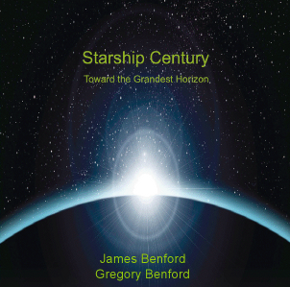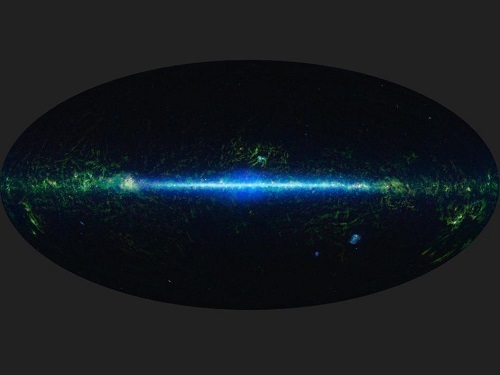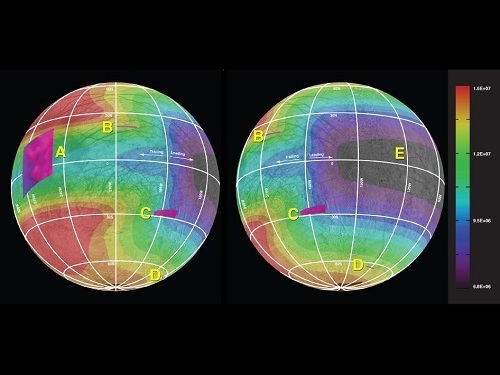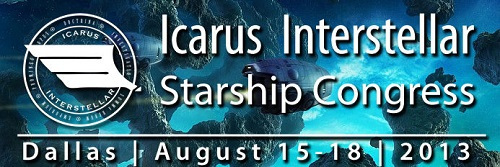Paul Gilster's Blog, page 227
April 22, 2013
Thoughts on Kepler 62 and Habitability
Because we only have direct images of a tiny number of planets orbiting other stars, we’re used to extrapolating as much as we can from our data and plugging in possible scenarios. But as the recent announcement of two ‘super-Earths’ around Kepler 62 demonstrates, we’re coming up hard against the limits of our knowledge. The comments on my recent story on the Kepler find bring up Greg Laughlin’s always interesting systemic site and a post he made in early April. Laughlin (UC-Santa Cruz) is worth reading not only for his shrewd analysis but for the sheer brio he brings to the exoplanet hunt. And here he sounds a note of caution:
I think we currently have substantially less understanding of the extrasolar planets than is generally assumed. Thousands of planets are known, but there is no strong evidence that any of them bear a particular resemblance to the planets within our own solar system. There’s always a tendency, perfectly encapsulated by the discipline of astrobiology, with its habitable zones and its preoccupation with water — to make wild extrapolations into the complete unknown.
Many Centauri Dreams readers don’t read the comments after each post, so I wanted to get that sentiment out in plain sight. One of the problems Laughlin notes is that if you plot the mass-radius relationships for super-Earths, you get numerous possibilities based on what we have found so far. We find what Laughlin calls a ‘huge range in apparent planetary structures’ here. Little more needs to be said: We’re tempted to look for clement conditions for astrobiology but we have to be careful that we don’t read our own hopes into still ambiguous results.
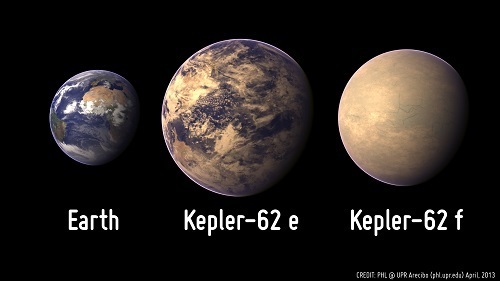
Image: A size comparison of Kepler 62 e and f as measured against the Earth. How much do the images contain our own hopes for astrobiology as opposed to what we really know? Credit: Planetary Habitability Laboratory.
Using data from the Allen Telescope Array, the SonATA program (SETI on the ATA) has continued to run a SETI search that focuses on Kepler candidates, especially those thought to be in the habitable zone of their stars. A recent news release homes in on the Kepler 62 finds, though with a caution that rings true in relation to Laughlin’s thoughts above. Clearly, Center for SETI Research head Gerry Harp would love to point his equipment at worlds with water on the surface, but in the case of Kepler 62 the mass of both habitable zone planets is unknown because they’re too small and too far away to analyze their gravitational effects on the host star.
Jon Jenkins, senior scientist at the Carl Sagan Center of the SETI Institute, is thus wise to take a measured approach:
“These discoveries move us farther down the road to discovering planets similar to Earth. While we don’t know if Kepler 62e and f are rocky or whether they have liquid water pooling on their surfaces, their existence shows that the incidence of small worlds in the habitable zone of sun-like stars is high. Thus we can look forward to the discovery and detailed characterization of Earth’s cousins in the years and decades to come by future missions and telescopes.“
And that seems like a legitimately cautious take-away from the Kepler 62 work. Of the five planets thus far identified around the star, two super-Earths seem to be in the habitable zone, but we can’t push definitively beyond that. The good news, as Laughlin notes on systemic, is that with the approval of TESS (Transiting Exoplanet Survey Satellite), we’re going to be discovering transiting super-Earths around the few million brightest stars close enough for detailed radial velocity follow-up, all of this within a scant ten years. TESS will provide the data we need to get a better understanding of the mass-radius relationships about which we have so many questions.
Blending Detection Methods with TRENDS
And while we’re talking exoplanets, let me take note of the TRENDS project (TaRgeting bENchmark-objects with Doppler Spectroscopy) being led by Justin Crepp (Notre Dame). Caltech’s John Johnson heads up Project Minerva at the university’s Exolab, recently described here as a telescope array dedicated to Earth-like planets around nearby stars, one capable of both radial velocimetry and transit studies. Crepp worked with Johnson as a postdoc and is now, like his mentor, combining exoplanet detection methods. TRENDS uses radial velocity measurements to identify promising targets for high-contrast imaging observations.
Initial results here are promising. The TRENDS team has discovered low-mass stellar companions orbiting HD 53665, HD 68017, and HD 71881 using NIRC2 adaptive optics (AO) observations. Its follow-up imaging has demonstrated common proper motion; i.e., co-moving companion objects with estimated spectral-types of K7–M0, M5, and M3–M4 respectively. These three M-dwarf companions could be found in the long-term Doppler trends of the host stars and the follow-up work at Keck then allowed their direct detection. From the paper:
Few mass, age, and metallicity benchmark dwarfs are known to date (Liu et al. 2007; Dupuy et al. 2010; Bowler et al. 2012a,b). The goal of the TRENDS high-contrast imaging program is to discover and characterize low-mass stellar and substellar companions with physical properties determined independently from spectro-photometric measurements, in order to calibrate theoretical atmospheric models and thermal evolutionary models. Each of the companions presented are amenable to direct spectroscopy using AO-fed integral-field units, such as OSIRIS at Keck or Project 1640 at Palomar.
This kind of news doesn’t drive the headlines, but we’re looking at important work. Crepp’s team is coming up with metallicity and age benchmarks, and further observation should produce mass benchmarks as well. Moreover, Johnson called my attention to another paper in which Crepp and colleagues characterize the brown dwarf HR7672B, establishing it as a “rare and precious ‘benchmark’ brown dwarf with a well-determined mass, age, and metallicity…” This is how you test your knowledge of the spectral and evolutionary models we need to make sense of what we see. Combining radial velocity and direct imaging clearly yields powerful new analysis.
The TRENDS work demonstrates improved ways to use our tools at the same time that it reminds us how much we have to learn. There is a raw excitement in pushing our methodologies in such synergistic ways. As we look forward to what projects like TESS will reveal in a few short years, we should keep in mind what while those Earth analogues are surely out there, tuning up our techniques will enable discoveries we haven’t begun to anticipate.
For more on TRENDS, see Crepp et al., “The TRENDS High-Contrast Imaging Survey. I. Three Benchmark M-dwarfs Orbiting Solar-type Stars,” accepted at The Astrophysical Journal (preprint). See also Crepp et al., “The Dynamical Mass and Three-dimensional Orbit of HR7672B: A Benchmark Brown Dwarf with High Eccentricity,” The Astrophysical Journal Volume 751, Issue 2 (2012), article id. 97 (abstract).






April 19, 2013
Starship Century Symposium May 21-22
The Arthur C. Clarke Center for Human Imagination is launching in May with what it describes as a ‘series of perspectives’ on what we can expect in the coming century. Its inaugural symposium begins on May 14 at the University of California at San Diego with discussions on design, artificial intelligence, synthetic life and science studies and thoughts from writers Jonathan Lethem and Kim Stanley Robinson on the literary imagination. But those with interstellar interests will want to put days 2 and 3 (May 21, 22) on their calendar, when the Starship Century Symposium convenes on the same site.
Gregory and James Benford have coordinated the latter event with the Clarke Center and will use it to present ideas on our possibilities among the stars as presented in their upcoming book Starship Century. Speakers will include prominent science fiction writers as well as many of the scientists most actively engaged in thinking about starflight. Thus we have Pete Worden (NASA Ames) as well as Neal Stephenson (The Diamond Age, Cryptonomicon, etc.) on the first morning, along with Robert Zubrin, of Mars Society fame, discussing what he calls the ‘economics of interstellar breakout.’ Futurist and business strategist Peter Schwartz will present “Starships and the Fates of Humankind.”
A section on the near-future including Geoffrey Landis on nuclear rocket options in the Solar System gives way the next morning to Adam Crowl’s talk on the development of starship concepts over the past century, Paul Davies on alien biospheres, Ian Crawford on interstellar destinations and John Cramer on exotic physics and the interstellar distance conundrum. Freeman Dyson offers a remarkable look (I’ve already seen this one) at what we might find as we move into the Kuiper Belt and the Oort Cloud beyond, especially in terms of how life might appear there or be created by human scientists working wonders with genetic engineering.
I’m told that available space is filling up fast. You can find the complete list of speakers and panelists, including Larry Niven, Jon Lomberg, Joe Haldeman, David Brin, Jill Tarter, Vernor Vinge and more, on the agenda page. Lodging is at the La Jolla Shores Hotel, with full details on the site. The Clarke Center frames the overall three-day event this way: Day 1 covers one-third of a century, the time between the creation of 2001: A Space Odyssey and the year it portrayed. Days 2 and 3 address what the Center calls “…a century long project: to create a starship.”
Addendum: Jim Benford has written to say that some of the material on the Starship Century site, from which I drew this article, is out of date. I’ll update with any schedule changes next week.






April 18, 2013
Water Worlds in the Habitable Zone
“The fault, dear Brutus, is not in our stars,
But in ourselves, that we are underlings.”
Thus Cassius speaking to Brutus in Shakespeare’s Julius Caesar, trying to convince him that what happens to us comes not from some malign fate but from our own actions. I’m sure he’s right, too, but I admit there are days when I wonder. For the stars seem aligned in such a way that whenever there is a significant news conference about exoplanets, I have a schedule conflict. This is true yet again today, so that I’m writing before the NASA-hosted news briefing and will have to set this up to post automatically after the embargo expires.
Here, though, are the main points. We have found Kepler 62f, an interesting world about 1.4 times the size of Earth and most likely rocky. When you add up the other known facts about the planet, the attention builds. Discovered through Kepler data in the constellation Lyra, this world receives about half the heat and radiation that the Earth does, while orbiting its star every 267.3 days. The University of Washington’s Eric Agol lays out the case for this intriguing planet:
“The planets this small that we have found until now have been very close to their stars and much too hot to be possibly habitable. This is the first one Kepler has found in the habitable zone that satisfies this small size. Kepler 62f is the smallest size and the most promising distance from its star, which by these measures makes it the most similar exoplanet to Earth that has been found by Kepler.”
The best guess — and remember that we lack knowledge of Kepler 62f’s mass and density — is that we’re looking at a rocky world with an atmosphere, but Agol doubts it’s a thick gaseous envelope like Neptune’s. We seem to be looking at a planet a bit larger and somewhat cooler than the Earth, and it’s not alone in this system, where four other planets are known to exist. One of these, Kepler 62e, is a fellow traveler in the star’s habitable zone. It’s about 1.61 times the size of Earth and orbits every 122.4 days, giving it 20 percent more stellar flux than the Earth.
Image: The newly discovered planets named Kepler 62e and f are super-Earths in the habitable zone of a distant sun-like star. The largest planet in the image, Kepler 62f, is farthest from its star and covered by ice. Kepler 62e, in the foreground, is nearer to its star and covered by dense clouds. Closer in orbits a Neptune-size ice giant with another small planet transiting its star. Both habitable-zone planets may be capable of supporting life. Credit: David A. Aguilar (CfA)
Two small super-Earths in the habitable zone make for understandable excitement. Modeling at the Harvard-Smithsonian Center for Astrophysics (CfA) suggests that both these planets are water worlds, completely covered with a global ocean. Might they have life? Lisa Kaltenegger (Max Planck Institute for Astronomy/CfA) speculates:
“These planets are unlike anything in our solar system. They have endless oceans. There may be life there, but could it be technology-based like ours? Life on these worlds would be under water with no easy access to metals, to electricity, or fire for metallurgy. Nonetheless, these worlds will still be beautiful blue planets circling an orange star — and maybe life’s inventiveness to get to a technology stage will surprise us.”
Kepler 62 is a class K star somewhat smaller and cooler than the Sun. According to the CfA’s models, Kepler 62e should be cloudier than the Earth, while the cooler Kepler 62f would need to take advantage of the greenhouse effect from carbon dioxide in the atmosphere to keep it warm enough for the ocean to remain liquid. Harvard’s Dimitar Sasselov notes in this CfA news release that discoveries like this raise the prospect of other stars with not one but two planets in the habitable zone. That conjures up what until recently was our view of the Solar System, when not so many decades ago we used to believe Venus and Mars might each be habitable worlds.
I think Sasselov is right to linger over this thought. These may be water worlds and most likely would not develop technological civilizations, but imagine a system where two worlds with continents and oceans, worlds much like Earth, existed close to each other in the habitable zone, each highly visible to the other. Surely the inhabitants of planets like these, with the prospect of a truly colonizable world this close, would be impelled to make the crossing.
The other planets around this star? Kepler 62 b, c and d are 1.31, 0.54 and 1.95 times the size of the Earth, respectively, all orbiting the star too tightly to be in the habitable zone. For more, see this University of Washington news release. Kaltenegger and Sasselov’s work is to be published in The Astrophysical Journal, while Agol is second author of the discovery paper published online in Science today as Borucki et al., “Kepler-62: A Five-Planet System with Planets of 1.4 and 1.6 Earth Radii in the Habitable Zone” (abstract).






April 17, 2013
Finding ET in the Data
As we saw yesterday, the Infrared Astronomical Satellite (IRAS) has been the source of data for a number of searches for unusual infrared signatures. The idea is to look for the artifacts of advanced extraterrestrial civilizations, under the assumption that a sufficiently advanced culture will be capable of engineering projects that could be detected from light years away. A Dyson sphere, existing either as a completely enclosed star or as a swarm of artifacts around a star, is but one example of such engineering, but it’s a sensible one to look for because it represents a way to maximize energy. It’s also theoretically detectable because of waste heat in the infrared.
These days, though, we have not just IRAS but the Wide-field Infrared Survey Explorer (WISE) and the Spitzer space telescope providing us with infrared data. Richard Carrigan’s pioneering work on interstellar archaeology is now complemented by searches funded by the New Frontiers in Astronomy & Cosmology program, set up by the Templeton Foundation and administered by the University of Chicago. The program has been created to provide grants in areas ranging from our universe’s role in a possible multiverse to the detection of intelligence beyond our Solar System. The team of Jason Wright (Pennsylvania State) and colleagues Steinn Sigurðsson and Matthew Povich is one of three grant winners in a tuned up Dyson artifact hunt.
As described by Stephen Battersby in Alien Megaprojects: The Hunt Has Begun, a recent article in New Scientist, this search should be able to expand Carrigan’s observations thousands of times farther, with the ability to detect a Dyson sphere around a Sun-like star almost anywhere in the galaxy. And this gets us into interesting terrain. From the article:
Even such a wide-ranging hunt may not be ambitious enough, according to Wright. He suspects that interstellar travel will prove no harder than constructing a sphere. An alien civilisation with such a high level of technology would spread out and colonise the galaxy in a few million years, building spheres as they go. “I would argue that it’s very hard for a spacefaring civilisation to die out. There are too many lifeboats,” says Wright. “Once you have self-sufficient colonies, you will take over the galaxy – you can’t even try to stop it because you can’t coordinate the actions of the colonies.”
A good point. And if this is the case, we would expect to find Dyson spheres, assuming we’re correct in thinking they represent a reasonable way to maximize the collection of energy. “To find one or a few Dyson spheres in our galaxy,” Wright goes on, “would be very strange.” In other words, there are either going to be a lot of them or none at all, and if there are a lot of them, then we might consider taking the hunt into extra-galactic territory. Wright tells Battersby that a galaxy colonized by a Kardashev Type III civilization should show up as a big, bright object in the infrared data from WISE, clearly flagged by virtue of the fact that it has no optical component.
How likely is it that things like Dyson spheres will ever be built? Wright has written about this on his AstroWright site, from which this quote:
…despite all of the advances in medicine, economics, and civilization generally, we are still growing as a species exponentially. We have long left Malthusian limits behind, and have shown that technology will progress faster than our resource demands. But no technology can give us more energy than hits the Earth until we start talking about spaceships (except for nuclear energy, which is an ultimately finite resource; fossil fuels are, ultimately, just stored energy from sunlight that hit plants millions of years ago, so, again, finite). We will continue to grow as a species until we hit a free energy resource limit, and then in order to further grow we will have to start collecting more solar energy. And we will have to start emitting that energy as waste heat. And that trend, too, will then have to proceed exponentially…
The consequences are interesting to contemplate.
Indeed. The approach is speculative and obviously depends on how an advanced civilization builds its energy collectors. Dyson spheres are one thing, but a thin ring of artifacts around a distant star is not going to be easily flagged even in the WISE data. A second survey, this one with a different approach, is in the hands of Princeton’s Lucianne Walkowicz, who with her four co-investigators will be looking through Kepler data for unusual patterns of variability. Here we’re in familiar territory with the analysis of light curves that has proven so productive in detecting exoplanets.
Will Walkowicz’ team find something spectacular? After all, their proposal is titled “Stellar Lighthouses: Decoding Signatures of Advanced Civilizations in Precision Stellar Photometry,” and any signature of something artificial around a distant star is going to change everything. But this is a search for more than Dyson spheres, just as ‘interstellar archaeology’ comprehends much more than a single postulated technology.
Suppose a distant civilization is using microwave beaming to drive spacecraft, or modifying its star’s makeup to prolong its life? Steinn Sigurðsson, blogging from the New Frontiers in Astronomy & Cosmology conference in 2012, recalled an old Analog story about the discovery of unusual stars, so bizarre that they demand immediate investigation. One turns out to have a convective zone spiked with manganese and one is bright green. The conclusion is that extraterrestrial pranksters are spiking the stars to draw attention. Who knows what may turn up, but as Walkowicz tells Battersby: “We know what transits, starspots and flares looks like, so we are looking for any variation we can’t explain through known astrophysics.”
Geoff Marcy (UC-Berkeley) is also in the hunt, working with the University of Hawaii at Honolulu’s Andrew Howard and John Johnson (Caltech) on the same kind of signal via Kepler data. The data, of course, are already in our possession, though we keep adding to the database. But it’s a fascinating speculation that we may already have detected signs of an extraterrestrial civilization without even realizing it. The hunt for astronomical anomalies means combing through vast amounts of data with a clear view of our own preconceptions and how they might mislead us. Marcy’s team will doubtless find unusual variability in a number of objects that can be explained through conventional means, but finding the inexplicable will get everyone’s attention.






April 16, 2013
Archaeology on an Interstellar Scale
Dyson spheres — technology wrapped around an entire star to maximize energy use — would be unimaginably big. But the idea of maximizing the light from a central star certainly makes sense. Imagine a sphere with a radius at the distance of Earth’s orbit. Now you’ve got a surface area more than 100 million times what’s available on our planet, a sensational venue for science fiction if nothing else. And you’re certainly changing the energy equation — our total power consumption today is the equivalent of about 0.01 percent of the sunlight falling on Earth, according to a new article in New Scientist. Keep energy demand growing at 1 percent per year and in a single millennium we’ll need more energy than strikes the surface of the planet.
Moving power generation into space is certainly something that would motivate a civilization a good deal more advanced than our own, and using abundant asteroid material, it could spread power generation entirely around the star. Stephen Battersby, who wrote Alien Megaprojects: The Hunt Has Begun, doubts they would create a single shell because it would be gravitationally unstable. But a Dyson ‘swarm’ is more plausible, with hordes of large power stations moving on independent orbits around the star. Dyson, who likes to talk about what is observable rather than what’s probable, thinks we could spot such a project through its waste heat in the infrared.
This wouldn’t be an easy catch because there are astronomical configurations — a young star in an envelope of gas and dust, for example — that radiate in the infrared in much the same way. But this, says Battersby, can be resolved:
…the infrared spectrum of these objects should be a giveaway. Silicate minerals in dust produce a distinctive broad peak in the spectrum, and molecules in a warm gas would produce bright or dark spectral lines at specific wavelengths. By contrast, waste heat from a sphere should have a smooth, featureless thermal spectrum. “We would be hoping that the spectrum looks boring,” says Matt Povich at the California State Polytechnic University in Pomona. “The more boring the better.”
Image: A mosaic of the images covering the entire sky as observed by the Wide-field Infrared Survey Explorer (WISE), part of its All-Sky Data Release. Since the Infrared Astronomical Satellite mission of 1983, we have added greatly to our databases of infrared objects. Will new searches help us locate a source with a clearly artificial signature? Image credit: NASA/JPL-Caltech/UCLA.
And that brings us to Vyacheslav Ivanovich Slysh, a Russian radio astronomer known for the so-called ‘Slysh formula,’ which helps determine the size of sources of synchrotron radiation, an important contribution to the study of active galactic nuclei. Known as well for his work on maser emission in star-forming regions, Slysh turned his attention in 1985 to a survey of infrared data in the hunt for Dyson objects, whether spheres or swarms. Battersby mentions Slysh only in passing, but the Russian work on what I usually refer to as ‘interstellar archaeology’ in these pages is quite interesting. In 2000, Slysh’s work was followed by M. Y. Timofeev, collaborating with Nikolai Kardashev, both efforts using data from the Infrared Astronomical Satellite.
Centauri Dreams readers will know to associate the search for extraterrestrial artifacts with Richard Carrigan, a scientist emeritus in the Accelerator Division at the Fermi National Accelerator Laboratory whose most recent search dates from 2009. Here’s what Carrigan says about the Slysh and Timofeev efforts in his Dyson Sphere Search History. Here he has just referred to a search by Jun Jugaku and Shiro Nishimura, looking for ‘partial’ Dyson spheres:
Slysh and Timofeev at al. have used the IRAS database for a different approach. Slysh investigates the flux at the maximum of a Dyson Sphere spectrum. He estimates that all Dyson Spheres with temperatures from 50 to 400 ºK within 1 kpc of the sun should have been detected. The Timofeev search looked at a population of IRAS sources in the 110-120 and 280-290 ºK temperature range as established by Kardashev and others and did Planck blackbody fits to the four IRAS bands. They fitted by minimizing to a Planck distribution. (Note that no Planck spectrum correction is made on the four measured fluxes from the filters.) Slysh identified one possible Dyson Sphere candidate, G357.3-1.3. The Timofeev at al. search identified 10 or so candidates but ruled out most of them, often on the basis of associations.
That figure of 1 kiloparsec (kpc) from the Sun identified with Slysh is chosen for a reason. In 1966, Carl Sagan and Russell Walker published a paper in The Astrophysical Journal on “The Infrared Detectability of Dyson Civilizations.” Their analysis showed that a search out to 1000 parsecs should be possible even with the technology of the day, but noted the problem of confusing a possible Dyson signature with natural phenomena. Carrigan’s 2009 search also used the IRAS data of 250,000 infrared sources (it covers 96 percent of the sky), looking for both full and partial Dyson spheres in the blackbody temperature region from 100 K to 600 K. Carrigan’s limits don’t go out as far. He says that IRAS’ Low Resolution Spectrometer was sensitive enough to find Dyson spheres out to 300 parsecs. That would encompass roughly a million solar-type stars.
Image: Richard Carrigan, who told New Scientist for its recent article: “I wanted to get into the mode of the British Museum, to go and look for artifacts.”
I’ve mentioned enough papers to begin a small bibliography, which I’ll list here, but go to Carrigan’s site for other references. I bring all this up for two reasons. First, new searches for extraterrestrial artifacts are in the works, about which more tomorrow. The other reason is that this work isn’t highly visible, but the change it represents from more conventional radio and optical SETI methods is profound. The change speaks not so much to the failure of earlier SETI to produce a result as to our growing understanding that civilizations substantially more advanced than our own — if they exist — could work with engineering on mind-boggling scales. Such engineering should be detectable, and we’ll look at new efforts to find it tomorrow.
The Slysh paper is “A Search in the Infrared to Microwave for Astroengineering Activity,” in The Search for Extraterrestrial Life: Recent Developments, M. D. Papagiannis (Editor), Reidel Pub. Co., Boston, Massachusetts, 1985, p. 315. Timofeev and Kardashev wrote “A Search of the IRAS Database for Evidence of Dyson Spheres,” Acta Astronautica 46 (2000), p. 655. The Sagan and Walker paper is “The Infrared Delectability of Dyson Civilizations,” Astrophysical Journal 144 (3), (1966), p. 1216. And Richard Carrigan’s 2009 study is “The IRAS-based Whole-Sky Upper Limit on Dyson Spheres,” Astrophysical Journal 698 (2009), pp. 2075-2086, available online.






April 15, 2013
Europa: Sulfates and Landing Sites
Last week’s post about the chemistry of Europa’s ocean is nicely complemented by new work on the moon’s interior by Brad Dalton (JPL) and colleagues. Like JPL’s Kevin Hand, who has been looking at the role of hydrogen peroxide in possible subsurface life there, Dalton is in the hunt for ways to learn more about the composition of Europa’s ocean. Both scientists have been using data from the Galileo mission, refining its results to produce new insights.
Usefully, the surface chemistry on Europa is affected by the charged particles continually striking the tiny world. That allows us to get a read on which parts of Europa would be the best targets for future spacecraft missions, for Dalton’s work helps us find the places where charged particles have had the smallest impact. It’s there — on parts of the leading hemisphere in Europa’s orbit — that material from within the ocean is most likely to be found in pristine condition, with the least chemical processing by incoming charged electrons and ions.
Here’s the mechanism: Europa keeps the same side toward Jupiter as it moves around the planet in its orbit. At the same time, Jupiter’s magnetic field is tugging ions of sulfur and oxygen from Io along the same path, as well as charged energetic particles that move much faster than Europa’s 3.6-day orbit. What happens is that the trailing hemisphere of Europa winds up with more sulfuric acid, apparently the result of sulfur ions bombarding the surface. Dalton’s team takes those earlier Galileo observations further by looking at five different parts of the surface.
Image: This graphic of Jupiter’s moon Europa maps a relationship between the amount of energy deposited onto the moon from charged-particle bombardment and the chemical contents of ice deposits on the surface in five areas of the moon (labeled A through E). Energetic ions and electrons tied to Jupiter’s powerful magnetic field smack into Europa as the field sweeps around Jupiter. The magnetic field travels around Jupiter even faster than Europa orbits the planet. Most of the energetic particles hitting Europa strike the moon’s “trailing hemisphere,” the half facing away from the direction Europa travels in its orbit. The “leading hemisphere,” facing in the direction of travel, receives fewer of the charged particles. Credit: NASA/JPL-Caltech/Univ. of Ariz./JHUAPL/Univ. of Colo.
Hydrated sulfuric acid and hydrated sulfate salts can be distinguished from water ice by the spectra gathered by Galileo’s Near-Infrared Mapping Spectrometer. Dalton and team are looking at the reflected light from frozen material on the surface, and comparing what they see with their models of what the particle bombardment from Jupiter and Io should produce. It turns out that sulfuric acid varies from undetectable levels near the center of the leading hemisphere to more than half of the surface materials near the center of the trailing hemisphere. The amount of electrons and sulfur ions hitting the surface shows a close correlation with this result.
So whatever chemical compounds may originally have erupted from the interior onto the surface, they’re most likely to be found unchanged on the leading edge. Says Dalton:
“The darkest material, on the trailing hemisphere, is probably the result of externally-driven chemical processing, with little of the original oceanic material intact. While investigating the products of surface chemistry driven by charged particles is still interesting from a scientific standpoint, there is a strong push within the community to characterize the contents of the ocean and determine whether it could support life. These kinds of places just might be the windows that allow us to do that.”
Europa is going to be a tough environment to work in given its high radiation environment. But work in it we must, because although oceans are also possible on Ganymede and Callisto, it’s Europa that seems to have thinnest crust, making it more likely that oceanic materials are preserved in frozen form on the surface there. To continue the investigation of Europan landing sites for future probes, another recent paper by Edward Sittler (University of Maryland) and team on plasma ion measurements near Europa makes that case that we need a 3-D model of the interactions between moon and magnetosphere to develop a global view of the electric and magnetic fields and the associated plasma environment our probes will have to work in.
The paper is Dalton et al., “Exogenic controls on sulfuric acid hydrate production at the surface of Europa,” Planetary and Space Science, Volume 77 (March 2013), pp. 45–63 (abstract). The Sittler paper is “Plasma Ion Composition Measurements for Europa,” available online at Planetary and Space Science 13 March 2013 (abstract).






April 12, 2013
Starship Congress
No stranger to these pages, Richard Obousy is president and senior scientist for Icarus Interstellar, which among other things is engaged in the ambitious redesign of Project Daedalus. But the organization has more on its plate than a fusion-powered starship. From worldships to lightsails, Icarus Interstellar is probing the possibilities both near-term and far, all of which will be discussed at an upcoming gathering of the interstellar community that Richard now describes.
by Richard Obousy

Starship Congress is the interstellar summit that Icarus Interstellar is hosting this summer in Dallas, August 15-18. As an event, Starship Congress will play host and give voice to a wide variety of interstellar organizations and distinguished proponents from the interstellar community. Registration for Starship Congress is now open on Icarus Interstellar’s website. A call-for-papers has been made with selected presenter’s papers to be published in a special Starship Congress-dedicated issue of the Journal of the British Interplanetary Society.
The event is split into three days, with each day advancing progressively in terms of its focus on the future of science and technology.
Day 1—Interstellar Now
Day 1 will examine what we can do today and for the next twenty years. The aim is getting the interstellar community to think about critical building blocks needing to be addressed in the near term in order to establish the correct social, economic and technological conditions leading to the building and launch of a starship before the end of the century.
Day 2—Interstellar This Lifetime
DAY 2 will be focused on semi-realistic targets for what we may see accomplished from 20-to-50 years from now. Likely areas of discussion will be technologies that are presently considered to be at low-technology readiness level (TRL). On the propulsion side of things this will include fusion and antimatter rockets. There will also be discussions on the human exploration and colonization of our own solar system as a plausible next-step on way to becoming an interstellar civilization.
Day 3—Interstellar Future
DAY 3 will be focused on topics that are deemed speculative by today’s standards. Warp drives, wormholes, the extraction of energy from the quantum vacuum, are examples of the kinds of talks and discussions that are planned. In addition, papers and presentations are anticipated on ‘mega-engineering’ projects such as space elevators and terraforming. The consideration of social aspects of long distance space exploration will be talked about. (For example, how do closed communities evolve in space, and how do we ensure the protection of minorities on such a mission while limiting religious extremism?) Similarly, another interesting topic can be the degree of autonomy an interstellar crew have from the population that funded their mission.
Speaking for myself, as president of Icarus Interstellar I’m deeply cognizant of the relatively low interest there is globally in putting money into space exploration, and therefore the questionable assertion that we’ll be ‘going interstellar’ anytime soon. As an example, the annual budget of the US Department of Defense is about equal to the sum total of money NASA has ever spent since its inception in 1958. However, I’m also mindful of the unpredictable effects of disruptive technologies and the profound social and technological advancements humanity has seen in the last century. So Icarus will stick to its ambition of launching an expansive campaign of interstellar exploration and colonization to commence by the end of the century.
Idealistic? Undoubtedly. Possible? Yes.





April 11, 2013
The Era of Planet Gathering
We’ve looked at a couple of exoplanet issues this week that bear further comment. The first is that different detection methods can be usefully combined to cover different scenarios. If radial velocity works best with larger planets closer to their star, direct imaging takes us deep into the outer planetary system. We saw yesterday how both imaging and radial velocity could be used to probe subgiant stars. We routinely use RV as a check on transiting planet candidates. And gravitational microlensing can find planets at a wide range of separation from their primary.
I think microlensing has plenty to teach us, though I’m sensitive to the criticism voiced in comments here that we’re dealing with non-repeating events when we have a microlensing detection. Centauri Dreams reader coolstar has also noted that distance may be a factor, questioning whether some of the resources by way of telescope hardware that we’re putting into microlensing studies wouldn’t be better employed looking at nearby worlds. After all, a new paper by Timothy Morton and Jonathan Swift makes the case that small planets around M-dwarfs are even more plentiful than recent studies reported here have shown. Maybe we should be putting more of an effort into finding these through transit studies?
If different detection methods each have their uses, radically different classes of telescope can likewise probe for planets. John Johnson (Caltech) heads up Project Minerva, a telescope array dedicated to Earth-like planets around nearby stars. The plan is to use small-aperture robotic telescopes atop Palomar Mountain to perform photometry and high-resolution spectroscopy, making it, according to Caltech’s site on the project, “the first U.S. observatory dedicated to exoplanetary science capable of both precise radial velocimetry and transit studies.” Following an initial design review, the project has now seen delivery of the enclosure for its telescopes.
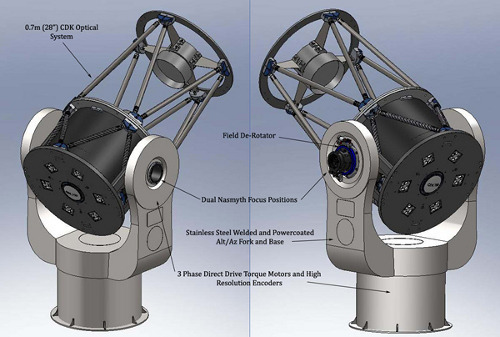
Image: Minerva’s hardware. Minerva will be an array of small-aperture robotic telescopes to be built atop Palomar Mountain outfitted for both photometry and high-resolution spectroscopy. It will be the first U.S. observatory dedicated to exoplanetary science capable of both precise radial velocimetry and transit studies. The multi-telescope concept will be implemented to either observe separate targets or a single target with a larger effective aperture. The flexibility of the observatory will maximize scientific potential and also provide ample opportunities for education and public outreach. The design and implementation of MINERVA will be carried out by postdoctoral and student researchers at Caltech. Credit: Caltech/John Johnson.
TESS, the Transiting Exoplanet Survey Satellite, stands as a logical follow-on to the Kepler mission because it takes the hunt to nearby stars even as Kepler’s candidate totals push on toward 3000. But as we wait for new instruments to come online, including the upcoming James Webb Space Telescope and ground-based systems like the European Extremely Large Telescope, it’s great to see grad students like Johnson’s Exolab crew coming up with solutions like Minerva. It’s an inexpensive effort that could gain real traction, and as Johnson told one reporter, “If we lived in an ideal world, we wouldn’t do Minerva because we’d have money from our funding agencies.” But then, who ever said it was an ideal world?
Minerva had a poster devoted to it at the most recent meeting of the American Astronomical Society. The plan is to use an array of four instruments, each with a 0.7-meter mirror, that will over a period of three years scan stars within about 75 light years of the Earth. To get a look at it, see Unblinking Baby Telescopes Will Hunt Exoplanets for Cheap, a recent piece that explains the project this way:
The Minerva telescopes will look for a slight wobble that indicates a planet is tugging gravitationally on those stars. Using this data, [graduate student Kristina] Hogstrom said that her team expects to find around a dozen new local planets, most of them two to three times the size of Earth and a few of them orbiting in the habitable zone where liquid water could exist. The project will also find Earth-sized planets and perhaps smaller, but these will likely orbit too close to their parent star to host life.
What I like about this, and I can see why Centauri Dreams readers find it interesting, is that it’s a dedicated exoplanet project that, Kepler-like, stares at a designated number of stars. The article quotes Johnson as saying that astronomers aren’t really in planet ‘hunting’ mode these days so much as engaged in routine planet ‘gathering,’ which tells you how far we’ve come in this remarkable enterprise in the few short years since 1995, when the announcement of the first planet discovered orbiting a main sequence star was made by Michel Mayor and Didier Queloz, to be quickly confirmed by Geoff Marcy and Paul Butler.
So here we are with off-the-shelf hardware and a custom-built spectrometer, running up a tab of about $3.5 million as compared to the $600 million that the relatively cheap space-based Kepler cost. We’re probably less than a year away from the datastream beginning to flow at the Minerva site. Modest funding and limited resources used imaginatively in arrays of small dedicated telescopes may be forced upon us by circumstance, but we’re learning that good science can flow from such projects and private institutions can find ways to fund them.






April 10, 2013
Planetary Systems Around Subgiant Stars
Our exoplanet detection methods have their limits. Radial velocity studies work great in the inner regions of planetary systems, but become more challenging as we move away from the star. Direct imaging is the reverse — we’re most likely to see a distant planet if it’s both large and well separated from the primary. Clearly we need to take the best data from each available method to characterize a planetary system. But direct images are rare and some stars — A-class in particular — are tricky for RV studies because of jitter and other problems. If you want to get in close to an intermediate mass star to look for planets or a debris disk, the way to do it seems to be to study ‘retired’ stars sitting on the subgiant branch of the Hertzsprung-Russell diagram.
These are stars that have slowed or stopped fusing hydrogen in their cores. Core contraction raises the star’s temperature enough to fuse hydrogen in a shell surrounding the core and the star begins to swell up toward giant status. A team led by Amy Bonsor (Institute de Planétologie et d’Astrophysique de Grenoble) has been looking at κ Coronae Borealis (κ CrB), also known as HD 142091, using data from the Herschel space telescope in the far infrared. κ CrB turns out to be unique, offering an example of a debris disc around a subgiant and “…a rare example of an intermediate mass star, where both planets and planetesimal belts have been detected.”
That brief quote from the paper on this work goes on to note that the planets and debris disk here can tell us something about planet formation around such stars. There is much we need to learn — some studies have found that more giant planets tend to form around higher mass stars than lower ones, and we’d like to tune up planet formation models in this area. κ Coronae Borealis is a star of about 1.8 solar masses at a distance of 100 light years, some 2.5 billion years old. Previous radial velocity work has revealed one giant planet of about two Jupiter masses orbiting at a distance similar to the asteroid belt in our Solar System. The paper presents Keck measurements offering evidence for a second companion whose mass is unclear.
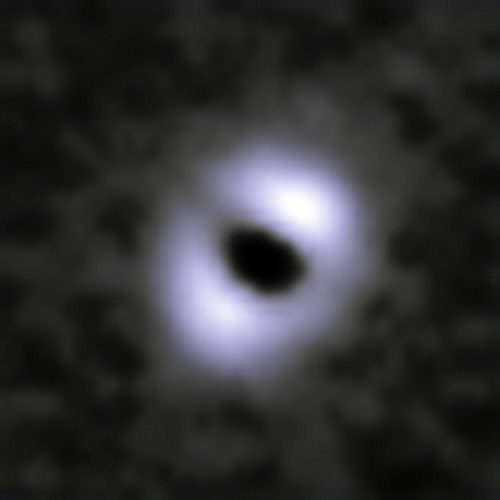
Image: Kappa Coronae Borealis, based on Herschel PACS observations at 100 μm. North is up and east is left. The star is in the centre of the frame (not visible in this graphic) with an excess of infrared emission detected around it, interpreted as a dusty debris disc containing asteroids and/or comets. The inclination of the planetary system is constrained at an angle of 60º from face-on. Credit: ESA/Bonsor et al (2013).
These observations yield several possible configurations for the debris disk and planets, with the interesting possibility that the disk may be divided into two narrow belts (centered at 40 AU and 165 AU respectively) with the outermost planet being in actuality a brown dwarf. Another model has a single continuous dust belt extending from 20 to 220 AU, with a planet sculpting the inner edge of the disk. A third possibility: The disk is being stirred by two planets so that the rate of dust production in the disk peaks at roughly 80 AU from the star. Says Bonsor: “It is a mysterious and intriguing system: is there a planet or even two planets sculpting one wide disc, or does the star have a brown dwarf companion that has split the disc in two?”
From the paper:
As the first example of a planetary system orbiting a subgiant, a more detailed population study is required to determine whether or not κ CrB is unusual, nonetheless, this work suggests that κ CrB did not suffer any dynamical instability that cleared out its planetary system, similar to the Late Heavy Bombardment. As the first example of a > 1.4M⊙ star, with a giant planet interior to 8AU, where there is also resolved imaging of a debris disc, κ CrB provides a good example system from which to further our understanding of planetary systems around intermediate mass stars.
The paper is Bonsor et al., “Spatially Resolved Images of Dust Belt(s) Around the Planet-hosting Subgiant κ CrB,” accepted for publication in Monthly Notices of the Royal Astronomical Society (preprint). More in this ESA news release.






April 9, 2013
The Chemistry of Europa’s Ocean
The news that hydrogen peroxide is found across much of the surface of Europa is intriguing. The global ocean beneath the moon’s icy crust would turn hydrogen peroxide into oxygen, assuming there is some mixing between the surface and the ocean. We don’t know if that mixing occurs, but if it does, then we may be looking at a useful chemical energy source for life. Given that I spent much of last week writing about Arthur C. Clarke, this thought invariably brings up a recent viewing of 2010: Odyssey II and the injunction beamed to Earth: “All these worlds are yours except Europa. Attempt no landing there.”
Europa is increasingly irresistible the more we learn about it. Here’s Kevin Hand (Jet Propulsion Laboratory) on the question of hydrogen peroxide’s possible role:
“Life as we know it needs liquid water, elements like carbon, nitrogen, phosphorus and sulfur, and it needs some form of chemical or light energy to get the business of life done. Europa has the liquid water and elements, and we think that compounds like peroxide might be an important part of the energy requirement. The availability of oxidants like peroxide on Earth was a critical part of the rise of complex, multicellular life.”
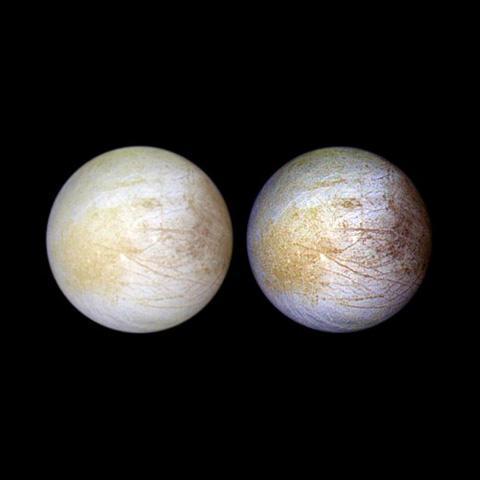
Image: This color composite view combines violet, green, and infrared images of Jupiter’s intriguing moon, Europa, for a view of the moon in natural color (left) and in enhanced color designed to bring out subtle color differences in the surface (right). The bright white and bluish part of Europa’s surface is composed mostly of water ice, with very few non-ice materials. In contrast, the brownish mottled regions on the right side of the image may be covered by hydrated salts and an unknown red component. The yellowish mottled terrain on the left side of the image is caused by some other unknown component. Long, dark lines are fractures in the crust, some of which are more than 3,000 kilometers (1,850 miles) long. Credit: JPL.
Hand and Caltech’s Mike Brown went to work on Europa using near-infrared data from the Keck II instrument on Mauna Kea. The hydrogen peroxide they found is some 20 times more diluted than what you might buy at the local drugstore, and it’s unevenly distributed on the surface. Here it’s important to remember that Europa is locked to Jupiter — it rotates on its axis once for every 86 hour orbit around the planet — so its hemispheres keep the same orientation toward Jupiter and, importantly, the radiation environment in the magnetosphere. In terms of hydrogen peroxide, the highest concentration (0.12 percent relative to water) is to be found on the leading side; i.e., the side that leads in Europa’s orbit around Jupiter. The side that faces backward in the moon’s orbit shows a concentration of peroxide that drops off to close to zero.
The work also shows that peroxide is at its highest concentration in areas where the ice is nearly pure water, a fact discussed in the paper, which ran in Astrophysical Journal Letters. It was the Galileo mission that first detected hydrogen peroxide on Europa, and the new work adjusts our view of its distribution. In the passage below, NIMS refers to the Galileo spacecraft’s Near-Infrared Spectrometer, which made the hydrogen peroxide detection:
…we note that the radiolytic production of surface oxidants has long been of interest in the context of Europa’s subsurface ocean chemistry (Gaidos et al. 1999; Chyba 2000; Chyba & Hand 2001). If Europa’s oxidant laden surface ice mixes with the ocean water then radiolysis could be a key mechanism for maintaining a chemically-rich and potentially habitable ocean (Chyba 2000; Hand et al. 2009). Previous estimates all assumed a globally uniform layer of peroxide within the ice layer and calculated delivery rates based the NIMS concentration of 0.13% relative to water.
But now we learn that the distribution is not globally uniform:
Our new results indicate that only the most ice-rich regions of Europa reach the concentrations measured by NIMS. The trailing hemisphere concentration is nearly an order of magnitude lower than the leading hemisphere and the sub- and anti-Jovian hemispheres are down by a factor of ∼3 relative to the leading hemisphere. As a result, the average global surface abundance of peroxide in the surface ice of Europa may be better represented by the sub- and anti-Jovian hemisphere concentrations of ∼0.044%. This reduces the low-end estimate of Chyba & Hand (2001) from ∼ 109 moles per year peroxide delivered to the ocean to ∼ 108 moles per year delivered.
Given its importance for the habitability of the global ocean, the more we learn about hydrogen peroxide and its distribution, the better. We’re refining the Galileo results, but hampered by the lack of resources in the Jovian system — the paper goes on to point out that the cold water ice regions of the poles are not readily observable from Earth. But the work lowers our estimates of the total oxidants delivered to the ocean, assuming that there is indeed exchange of material between the surface ice and the water below. The case for a habitable ocean is still there to be made, but until we know more about delivery mechanisms, we’re left with huge imponderables.
The paper is Hand and Brown, “Keck II Observations of Hemispherical Differences in H2O2 on Europa,” Astrophysical Journal Letters 766 (2013), L21 (preprint). More in this JPL news release.






Paul Gilster's Blog
- Paul Gilster's profile
- 7 followers


